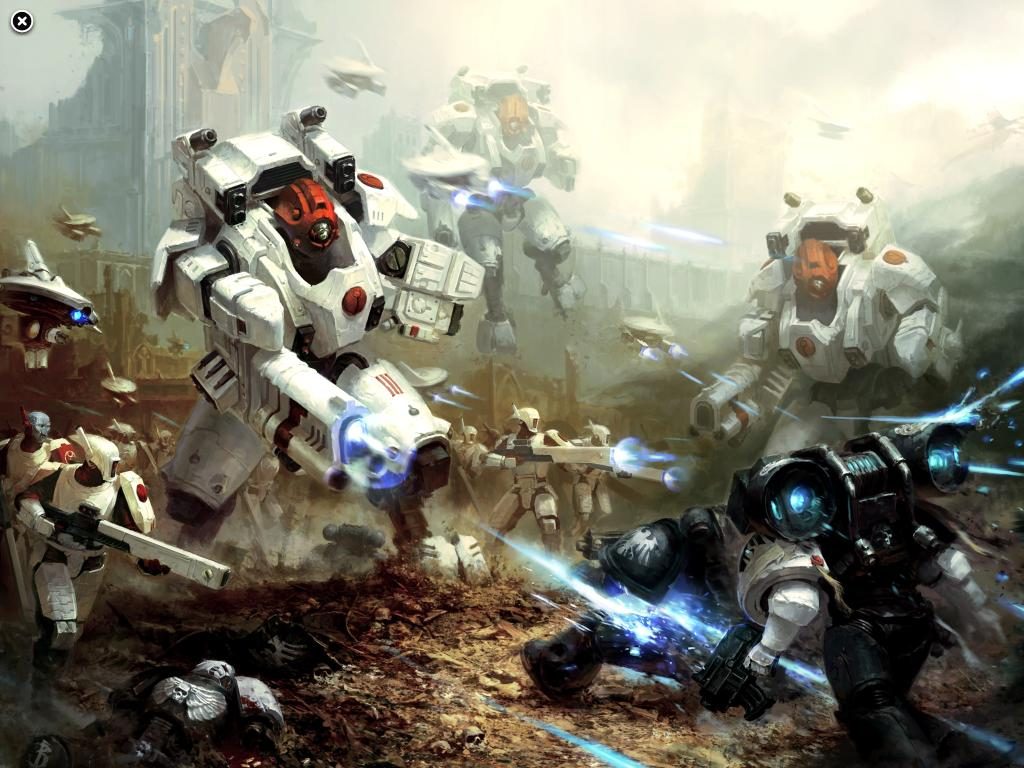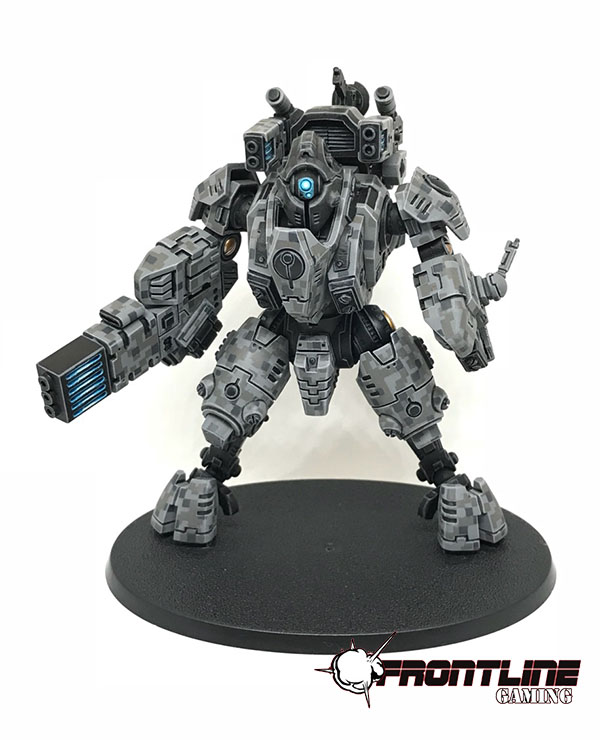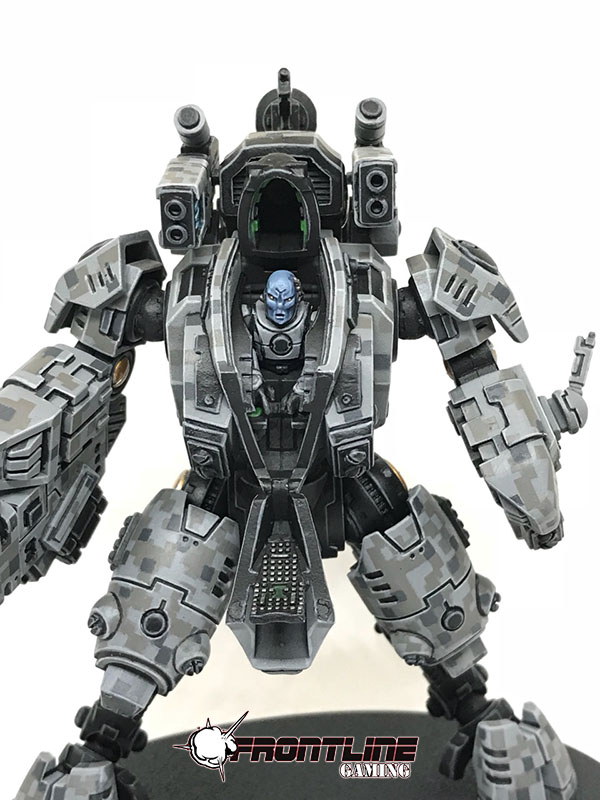
Last week I discussed a couple of options for T’au players who want to avoid Commanders now that the Fly keyword isn’t nearly as strong as it was in 8th. As always, check the Tactics Corner for more great articles!
I briefly talked about the Ghostkeel and the Tiger Shark, but this week I want to take a more detailed look at the Ghostkeel.
Everyone knows that T’au in 8th edition really only had one competitive list — Riptides, Commanders, and Drone spam — and while it’s too early in the edition to predict how a competitive T’au army is going to look, I want to make the best case for taking some of the lesser-seen models in the codex.
The Ghostkeel is in an interesting place at the moment. It doesn’t offer T’au players much in the way of offensive output, but it does offer some useful utility in other areas of the game. Whether this utility makes up for the lackluster shooting of the model is yet to be decided. As 9th edition goes on, we’re going to see lists evolve and change, so it’s certainly feasible that the Ghostkeel could make an appearance in some strong lists.
However, I’m a little skeptical that we’re going to see much of the Ghostkeel unless the 9th edition T’au codex updates its stat-line and abilities. This is certainly possible, and towards the end of this article I’m going to make a couple of suggestions that would bring the Ghostkeel into line with similarly-priced units in other codex books.
With this in mind, let’s begin with a comparison. For Space Marine players, the Invictor Tactical Warsuit plays a similar role to the Ghostkeel: it is a mid-sized unit that can deploy anywhere on the board that is not in the enemy deployment zone nor within 9″ of an enemy model. Moreover, it’s points cost is roughly comparable: 165 points for the Invictor and 171 points for the Ghostkeel.
For 165 points, the Invictor gets Marine players a fragstorm grenade launcher, a heavy bolter, two ironhail heavy stubbers, and a twin ironhail autocannon. For 176 points the Ghostkeel gets T’au players two burst cannons and a cyclic ion raker.
Let’s dig a little deeper into these shooting options. The Invictor has a total of 15 plus D6 shots. The two ironhail heavy stubbers offer six strength 4, AP-1, damage 1 shots at 36″; the heavy bolter offers three strength 5, AP-1, damage 1 shots at 36″; the twin ironhail autocannon offers six shots at strength 7, AP-1, damage 1 at 48″; and the fragstorm grenade launcher offers D6 blast shots at strength 4, AP0, damage 1 at 18″.
As shooting goes, this is respectable output for a model of this points cost. While it’s not going to bring down anything big, the Invictor will do some solid work against most infantry targets in the game, and it has the range to be a consistent threat regardless of positioning.
The Ghostkeel has 14 shots. The two burst cannons offer eight strength 5, AP-1, damage 1 shots at 18″ and the cyclic ion raker offers six strength 7, AP-2, damage 1 shots at 24″. The T’au player can overcharge the CIR for an extra point of strength and D3 damage at the cost of mortal wounds on 1s to hit. Note that I’m presuming that the T’au players takes the advanced targeting system for an extra point of armor piercing. Moreover, the points cost above presumes that the T’au player also takes a shield generator. It is this support system that makes the Ghostkeel an interesting option, but we’ll come to that in a moment.
In this loadout, the Ghostkeel will threaten some light to medium infantry, but will struggle to do much work against most other targets. While the CIR’s stat-line is respectable, the Ghostkeel will hit its target on average three times and will wound a further two against most targets. For the points cost, this is quite underwhelming.
There are a handful of other comparisons to similarly-priced options in a variety of other factions, but the Ghostkeel seldom comes out looking good.
And I accept that comparing two units in a vacuum has significant drawbacks. There is a lot more to both Space Marines and T’au that can improve these two units, but as a simple, broad-brush comparison I think there is at least some use in this comparison.
But it’s an unfortunate fact of this model: the Ghostkeel simply doesn’t offer much bang for its buck.
Before we get too negative, I mention above that T’au players can equip their stealthy lad with a shield generator. It’s here that things start to look up. With the native -1 to hit, and a 4++, the Ghostkeel starts to look more appealing as a defensive asset than an offensive one.

With toughness 6, a 3+ save, a 4+ invulnerable save, and a native -1 to hit, the Ghostkeel can be quite a pain for opponents to remove.
And what’s more, nearby Drones can use the savoir protocols ability to intercept incoming firepower.
Granted, consistent, high-quality firepower will certainly take it off the table, but at the very least this unit forces opponents to think twice when deciding what firepower to employ. A canny T’au player will use this to his advantage.
I think there’s some play here. As a part of a back-field castle, the Ghostkeel doesn’t offer T’au players enough firepower. But as a mobile, mid-board harassment unit, there’s something to be said for it. It’s quick, and with the correct support systems it’s tough enough to get stuck in with a variety of enemy units.
The Ghostkeel, then, will reward more aggressive play. In 9th edition, games are won and lost on the objectives, and the Ghostkeel can be useful tool in contesting and capturing mid-board objectives. It won’t, however, be able to do so on it’s own. Drone support will help to keep it alive for longer and a couple of units will help with overwatch. Indeed, now that Battlesuits can no longer fall back and shoot, T’au players need to leverage our powerful overwatch abilities in order to disincentivise the opponent’s combat units.
T’au players should also consider using the Ghostkeel in the charge and combat phases of the game. Of course, it has little to no combat ability to speak of, but that wouldn’t be the goal of charging the enemy.
We’ve already established that the Ghostkeel doesn’t offer much in terms of offensive output. This means that if we lose a turn or two of shooting, we haven’t lost too much.
With it’s respectable defensive capabilities, the Ghostkeel can take a punch or two and keep on going, so T’au players should leverage this in order to turn off an opposing unit’s shooting and charging. Our Battlesuit could, for example, charge a squad of Intercessors, and while the Marines could certainly do a couple or three wounds in combat, the Ghostkeel would almost certainly survive. We’ve now shut down that unit in the following turn.
Such an aggressive tactic shouldn’t be used in every case, of course, but it should be an option in the T’au player’s toolkit.
Finally, I want to mention a couple of improvements that would make the Ghostkeel a strong choice for the points. At the moment, it has some use, but it’s certainly not an auto-include. How could Games Workshop rewrite this unit in order to make it much more appealing?
I would keep things simple: increase the wounds from 10 to 12, increase the CIR’s profile from heavy 6 to heavy 8, and give it a 12″ no-reinforcements aura.
The first two are simple enough. Make the model more tough and more dangerous. This is pretty simple stuff. But it’s the third suggestion that I think could be really cool.
I suggest this rule specifically because The Greater Good introduced the very same ability — but in the form of a relic, the Advanced EM Scrambler.
It’s a great ability, but there are other very strong T’au relics, so it’s not at all surprising that we so seldom see it on the tabletop. Moreover, it would only apply to one Ghostkeel. Making the ability native to the model itself would give T’au players a strong incentive to take one or two Ghostkeels in their armies. The ability to block out areas of the board in which the opponent cannot place his reserve units is very strong.
Who knows what the next T’au codex will do for the Ghostkeel. I hope that GW does something interesting with it. It’s such a fantastic sculpt, and it would be great to see more variety on the tabletop.
Until that point, however, I think that the Ghostkeel still has some play.
And remember, Frontline Gaming sells gaming products at a discount, every day in their webcart!




Counterpoints:
1. The Ghostkeel only gets a -1 to hit when the attacker is more than 12″ away. The drones that give it an additional -1 are a separate unit and can easily be trimmed away. For a unit that is meant to be operating close to the enemy, it’s a terrible arrangement.
2. Less survivable but as expensive (or more so) than a tank. The Shield Generator has a 50/50 chance of working so averages means you’ll get rid of this thing with less effort than the ‘Keel costs, particularly if it doesn’t have a mass of drones nearby, such as when it sets up aggressively.
The lack of native -1 to hit is dumb – give it the same benefit as a Stealth Suit otherwise it’s just costing more for an ability that cannot be used.
The idea behind its countermeasures ability is to force the opponent into a devil’s choice- either get in close where they are at the Ghostkeel’s ideal range, or stay far away but be unable to effectively hurt it.
Or at least that’s the theory, but the reality is most armies want to engage Tau at close range because of their complete lack of melee, so it actually ends up being less of a choice and more of a “oh okay whatever” kind of ability.
Between Savior Protocols, hit penalties, and the Shield Generator it’s significantly more survivable than almost any vehicle in the game, though.
I was thinking along these lines and have given Ghostkeels a try in 9th. Sadly I was not too impressed, they are reasonably durable for their points but their lack of threat means that an opponent can just ignore them. They also lack scoring threat as a single model lacking ObSec.
That does not mean that they have no use. If pre-emptive objective grabbing lists such as nurgling spam become popular then the Ghostkeel definitely has a role as a way to block out a couple of objectives from being camped before the game even starts, seriously compromising the plans of your opponent.
The problem with the Ghostkeel is that as a durable brick it tends to lose out to Riptides and as a positional utility piece it competes with the much cheaper Stealth teams. That leaves it in an awkward spot where it is 2nd best choice for a number of possible roles rather than 1st choice for any.
Problem with GK all along 8th edition was the rule set. To be honest, as many of other Tau units, he was designed with enough “love”
I hope this to be adressed when codex come out as Tau will need these type of units to score
You forgot to mention big part of ghost keel, and that is that it just comboes well with stealth suits. Wall of mirrors lets you redeploy them and this doesn’t count as fallback. This makes ghostkeel-stealth suits combo strong since both of those units can start up board, grab objectives early, and hold the line. This is Huge, because Tau defends objectives very well, but has problems with taking them for themselves. Anything that helps in that department is huge buff.
Two, it’s a monster, and screens for our characters, mainly commanders. And thus i would suggest not actually investing in its offensive capabilities. 2 flamers, CIR, shield genrator and drone controller(for marker drones) and Stealth drones sum up to 155 pts, and that is good price for huge utility it gives.
It will eventualy end up in combat, so you don’t want to invest in its puny combat capabilities in case you want to fall back.
Its not killy unit so don’t treat it like one. It doesn’t have to be, its not 8th ed anymore.
Really good point! GK needs Stealth suits to work fine. They have good synergies with Wall of Mirror and the drones that stealh suits can carry
I dont think GK can work without support
Killing is not critical the way it was in 8E, but the issue is that Tau need ways to take objectives- and the Ghostkeel, being a single model with no ObSec, cannot do this particularly effectively. Yes, it will wipe out that squad of Primaris Marines with a round or two of shooting, but in the meantime they are holding the objective and earning victory points, driving the Tau player deeper onto the back foot.
What Tau struggle with is holding the midfield. The Ghostkeel, despite its survivability and infiltrating abilities, does not enable the army to do that any better. That’s why it is not particularly enticing as a choice.
(That said, Wall of Mirrors is a very nice trick, just not sufficient.)
That’s true. But their main objective is to create space and give rest of the army time to get into position. Even charging ghostkeel or stealths into enemy lines to body block can be god way of using it. Mobility is key in this edition, and since we cant generally leverage in any way to gain more, we need to think how to reduce it for our opponents.
Once rest of the army is onto objectives tau defends them actually quite well. Its just that once the lose it, they have little way to grab them back.